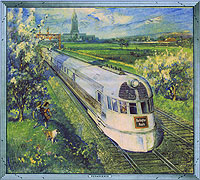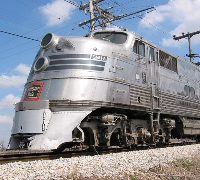|
In 1925, the Burlington adopted its most widely remembered steam locomotive lettering scheme,
and one of the earliest drawings for this scheme, dated April 27, 1927, is reproduced here.
The design for the first time employed the Burlington Route herald, displayed centered on the tender. This herald
changed somewhat over the years, and the version adopted in 1940 appears on the back page. It was at this time (1940)
that, on steam locomotive tenders and the cabs of black-painted diesels, a gold border was added outside the red band.
Speaking of gold, the color was used for all locomotive lettering, as well as for the lettering and striping on the
Burlington Route herald. On passenger locomotives, the color was a true gold color (though not real gold leaf), applied
as decals with a protective varnish coating. On freight and switching locomotives, a yellow imitation gold paint,
called Dulux Gold by Dupont Paints, was employed, both for lettering and on the herald. In the final decade of steam
operations, and occasionally earlier, the distinction between the use of gold and Dulux Gold blurred, and "real"
gold lettering could be found on freight power. Also, Scotchlite herald decals began to be used on tenders--particularly
for the very large heralds employed on class M-4, 0-5 and S-4 locomotives. These Scotchlite heralds featured reflective
white letters and stripes.
The Fort Worth & Denver adopted this lettering style shortly after it was introduced by the Q. But the Colorado
& Southern experimented with several designs of its own before finally adopting the Q version in 1928. Both roads--
and also C&S-FW&D subsidiary Wichita Valley--simply substituted their own, initials for those of the CB&Q
on the cab sides.
One note about the 1927 drawing: It shows the word "LIGNITE," to be lettered at the rear of the coal bunker
coping on both sides of the tenders of lignite- burning locomotives on Lines West. There is no evidence, however, to
indicate that this lettering was ever actually applied, an extensive search of photos--particularly those Views made by
Otto Perry in the late Twenties in the lignite- burning regions of Lines West--having turned up no examples. Instead,
a 1-foot square of Dulux Gold (yellow) was painted on the coal bunker coping to identify lignite-burners.
Another note: When locomotives were shopped, the cab roofs were normally painted mineral red, but this color was
rapidly discolored by soot and smoke to the point that it was often indistinguishable from the black paint around it. |


